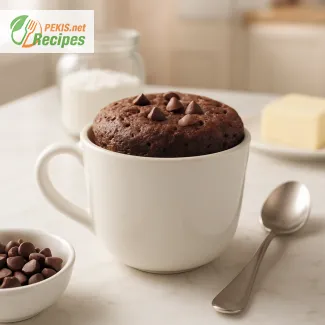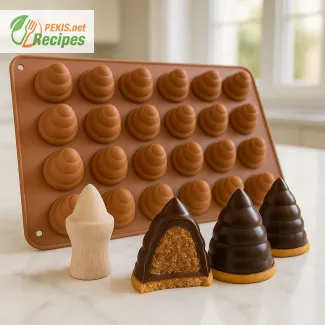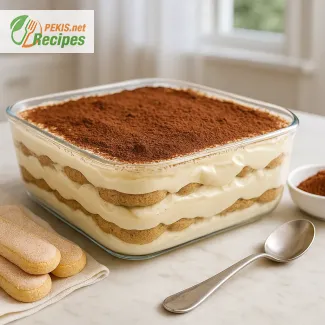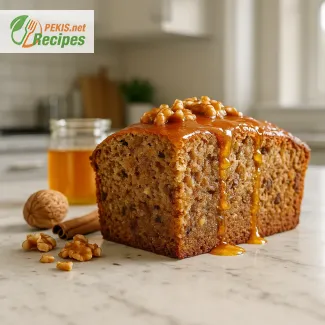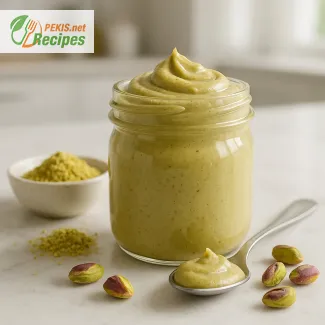Serving 8 portions, this silk-rolled matcha taiyaki cake blends airy sponge, ceremonial matcha, and silky cream filling into a light yet indulgent dessert ready in 25 minutes prep, 15 minutes baking, total 40 minutes. Its soft, elastic texture and delicate green hue make it both visually striking and perfectly balanced in flavor. Best enjoyed chilled, it keeps fresh for up to 2 days in the refrigerator, preserving its smooth, melt-in-mouth structure. Ideal for tea gatherings or elegant celebrations, this refined roll captures the harmony of Japanese matcha tradition and modern pâtisserie artistry.
I’m PEKIS – a professional chef and recipe developer with over 25 years of experience in cooking and baking, specializing in European and international cuisine. I’ve spent years refining desserts that balance texture, aroma, and presentation, and this silk-rolled matcha taiyaki cake reflects exactly that precision. My background in pastry techniques helped me perfect the elastic sponge and silky cream structure, capturing that smooth, cloud-like bite that defines the best Japanese-inspired cakes.
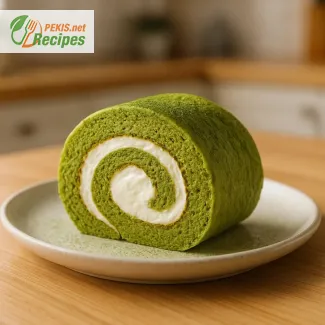
Elegant layers of matcha and airy sponge harmony
A Japanese-inspired dessert blending tradition with modern finesse
Delicate, silky layers of matcha-infused sponge roll seamlessly around a light, creamy filling, creating a dessert that embodies both Japanese precision and French pâtisserie elegance. Each bite reveals a soft cloud-like texture balanced with the earthy bitterness of ceremonial matcha, its subtle notes enhanced by the natural sweetness of the cream. This silk-rolled matcha taiyaki cake captures a luxurious mouthfeel — smooth, velvety, and slightly elastic — that dissolves effortlessly on the palate.
Unlike traditional taiyaki, which is shaped like a fish and filled with red bean paste, this modern reinterpretation transforms the idea into a rolled sponge creation inspired by Japanese street desserts and European Swiss rolls. The result is an exquisite combination of airiness, visual appeal, and umami depth, making it both a comforting and refined indulgence.
The essence of texture and flavor balance
What defines the perfection of this dessert is its structure — the sponge must be elastic yet soft, the filling light yet stable, and the matcha flavor vibrant without overpowering. High-quality matcha brings color and sophistication, while fresh cream, a touch of condensed milk, or white chocolate adds harmony and richness. Every component serves a purpose: the eggs give the cake its signature elasticity, while sugar stabilizes the texture during whipping, helping achieve that silky surface and rolled precision without cracks.
Moisture is the soul of this dessert. Slightly underbaked sponge locks in humidity, preserving the characteristic “silk roll” softness. The balance between aeration and fat is delicate — too little air, and the sponge feels dense; too much, and it becomes fragile. The goal is a creamy, melt-in-mouth structure that holds perfectly even after refrigeration.
A short history of matcha taiyaki evolution
The concept of taiyaki originated in Japan in the early 1900s, symbolizing luck and prosperity. Traditionally filled with azuki beans and baked in fish-shaped molds, taiyaki has evolved into countless forms — from custard and chocolate to savory variations. The matcha-rolled version emerged from modern Japanese cafés that began merging Western techniques with native ingredients. By the 2010s, the fusion of matcha, roll cake, and taiyaki imagery became a visual trend across Asia, admired for its photogenic presentation and delicate craftsmanship.
In this adaptation, the recipe takes inspiration from Kyoto-style patisseries, where chefs focus on “shibumi” — quiet elegance. The subtle bitterness of matcha complements the sweetness of the filling, embodying the balance between contrast and serenity that defines fine Japanese desserts.
Why you’ll love this recipe
- Visually stunning: the spiral of green and cream looks beautiful when sliced.
- Featherlight texture: soft, moist, and delicate — melts effortlessly in the mouth.
- Perfect flavor harmony: earthy matcha balanced by sweet, silky filling.
- Adaptable: pairs well with red bean, vanilla, or citrus accents.
- Ideal for any occasion: from elegant tea ceremonies to modern dessert tables.
How ingredients influence the final texture
Each element of the silk-rolled matcha taiyaki cake contributes to its unique sensory experience:
- Matcha powder gives both aroma and natural coloring; the finer the grind, the smoother the sponge.
- Cake flour ensures a delicate crumb, allowing the roll to stay flexible without breaking.
- Eggs add volume and elasticity, holding air during whisking to achieve that soft bounce.
- Sugar stabilizes proteins, helping maintain moisture during baking.
- Fresh cream or mascarpone in the filling balances bitterness with creamy sweetness.
- A touch of vanilla or white chocolate enhances the umami and complements the matcha’s depth.
This dessert thrives on temperature control and precision. Whipped eggs should retain their structure without curdling, and the sponge must cool under a damp cloth to preserve its moisture.
Storage and make-ahead preparation
Because of its moisture content and cream filling, this roll cake keeps best refrigerated for up to two days in an airtight container. For make-ahead preparation, the sponge can be baked a day earlier and stored wrapped in parchment to maintain elasticity. The filling should be added just before serving to ensure the signature silkiness remains intact. Avoid freezing, as it may alter the cream texture and break the smooth layers.
Creative variations and serving ideas
Experimenting with flavor layers turns this refined dessert into an artistic centerpiece:
- Replace the filling with sweet red bean paste or black sesame cream for a more traditional touch.
- Add yuzu zest or a hint of coconut milk for tropical brightness.
- For a festive version, decorate with gold dust or matcha drizzle.
- Serve with iced matcha latte, hojicha tea, or white chocolate shards for a luxurious pairing.
Cultural fusion in modern patisserie
This creation unites multiple culinary entities — matcha, taiyaki, Japanese roll cake, and French pâtisserie techniques — forming a dessert that transcends borders. It’s both nostalgic and avant-garde: rooted in Japanese street food culture yet refined enough for fine dining. The artistry lies in precision, patience, and respect for simplicity, where every texture and hue tells a story of craftsmanship.
This silk-rolled matcha taiyaki cake isn’t merely a dessert; it’s a sensory narrative of balance, lightness, and visual grace — a true celebration of how Eastern and Western traditions can intertwine into a single, velvety masterpiece.
- Preheat the oven to 180 °C (356 °F). Line a 25×35 cm (10×14 inch) baking tray with parchment paper.
- Separate the eggs. Beat egg whites with sugar until stiff peaks form.
- In a separate bowl, whisk egg yolks, milk, oil, vanilla, and salt until smooth.
- Sift flour, cornstarch, and matcha powder together to remove lumps and achieve even color.
- Gently fold the dry ingredients into the yolk mixture. Then carefully incorporate one-third of the whipped whites at a time, using a spatula to maintain airiness.
- Pour the batter onto the prepared tray and spread evenly. Tap lightly to remove air bubbles.
- Bake for 12–15 minutes until the surface is springy to touch and slightly golden at the edges.
- Remove from oven and cover with parchment paper. Cool completely under a damp towel to retain elasticity.
- In a chilled bowl, whip cream with powdered sugar until medium peaks form. Add melted white chocolate and mix gently to create a silky, stable filling.
- Unroll the sponge carefully, spread the cream evenly, leaving 1 cm (0.4 inch) from the edges.
- Roll tightly using the parchment paper for support. Wrap and refrigerate for at least 1 hour before slicing.
- Dust with matcha powder before serving for a refined finish.
FAQ questionWhat matcha should I use for the best color and flavor?
Choose ceremonial-grade matcha for a vivid green hue and clean, grassy flavor without harsh bitterness. Culinary grade works in a pinch, but ceremonial grade gives a silkier finish and more aromatic intensity with less powder needed.
FAQ questionHow do I keep the roll from cracking when I shape it?
Bake the sponge just until springy, then cool it covered (parchment + a lightly damp towel) to trap moisture. Roll the cake while it’s slightly warm to set the “memory,” and avoid over-whipping whites (too stiff = fragile crumb). A thin, even layer of batter and gentle folding preserve elasticity.
FAQ questionCan I make the filling more stable for clean slices?
Yes—fold melted white chocolate into softly whipped cream for light structure without heaviness, or whisk in a small dose of mascarpone for body. Chill the filled roll at least 60 minutes; cold, set cream yields neater cuts and a silky mouthfeel.
FAQ questionWhat fillings pair best with matcha without overpowering it?
Aim for balanced sweetness and fat: lightly sweetened whipped cream, vanilla-mascarpone, or sweet red bean paste for a traditional note. Bright accents like yuzu zest or strawberry compote (decoration/serving) add contrast while keeping matcha’s earthy depth front and center.
FAQ questionHow do I maintain that bright green color after baking?
Use fresh, high-quality matcha, sift it well, and avoid over-baking (excess heat dulls chlorophyll). Keep the batter away from prolonged light and air before baking, and cool quickly after it leaves the oven. Finishing with a light dusting of matcha (decoration) right before serving restores vibrancy.
FAQ questionCan I make it ahead, and how should I store leftovers?
Bake the sponge one day ahead, wrap in parchment to retain elasticity, and fill on the day of serving. Store the finished roll airtight, refrigerated up to 2 days. Avoid freezing—the cream matrix may separate, losing the dessert’s silky texture.
The silk-rolled matcha taiyaki cake brings together the artistry of Japanese flavor balance and the precision of European pastry craft. Every layer tells a story — from the gentle elasticity of the sponge to the velvet cream filling that melts with the warmth of a sip of tea. The interplay between bitterness and sweetness, airiness and depth, makes it more than a dessert; it becomes a calm, sensory ritual on a plate.
This creation reflects how texture defines emotion in food. The light roll, tinted with matcha’s natural green, feels comforting yet sophisticated. When prepared with care, it delivers consistency, smoothness, and visual appeal, capturing that rare harmony between tradition and innovation that every modern patisserie strives for.
Enjoying a slice after it has rested in the fridge reveals the full balance — the cool, creamy center, the subtle tea fragrance, and the delicate sweetness that lingers. It’s the kind of dessert that connects mindful craftsmanship with genuine pleasure, inviting you to pause and savor.
More than a trend, it’s a symbol of how culinary precision and cultural fusion can create something timeless — a dessert that embodies patience, creativity, and elegance in every bite.
Allergens present in the recipe:
- Eggs
- Gluten (from cake flour)
- Dairy (milk, cream, white chocolate)
- Soy (in white chocolate, depending on brand)
Substitution tips to reduce allergens and gluten:
- Replace cake flour with gluten-free all-purpose flour blend to make it gluten-free.
- Substitute dairy with plant-based milk and vegan whipping cream.
- Use vegan white chocolate or omit chocolate entirely for a lighter version.
- For egg allergies, use aquafaba (chickpea water) whipped with sugar for foam stability.
- Vitamin A: 130 µg – supports vision and skin health.
- Vitamin B2 (Riboflavin): 0.18 mg – aids metabolism and energy production.
- Vitamin D: 0.7 µg – strengthens bones and immune system.
- Calcium: 68 mg – important for bone structure.
- Iron: 0.9 mg – contributes to red blood cell production.
- Potassium: 140 mg – regulates fluid balance and nerve function.
- Magnesium: 14 mg – supports muscle and nerve function.
- Catechins from matcha: 180 mg – powerful antioxidants that help reduce oxidative stress.
- Polyphenols from cocoa butter: 45 mg – support cardiovascular health.
- Vitamin E: 0.7 mg – protects cells from free radical damage.
- Flavonoids: 30 mg – contribute to anti-inflammatory effects.
